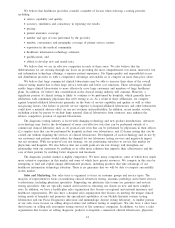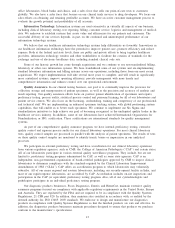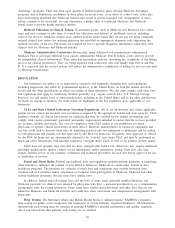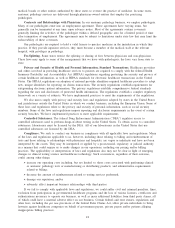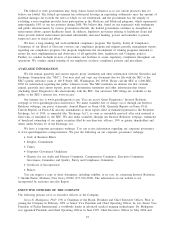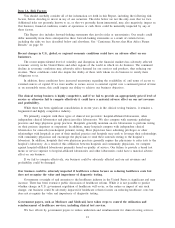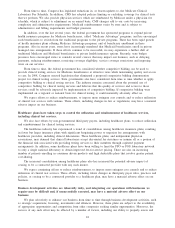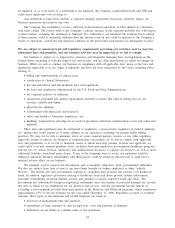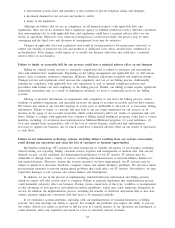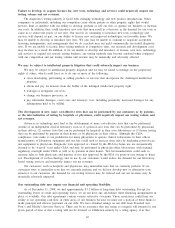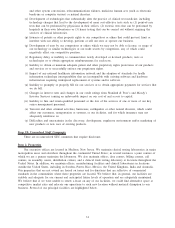Quest Diagnostics 2008 Annual Report Download - page 33
Download and view the complete annual report
Please find page 33 of the 2008 Quest Diagnostics annual report below. You can navigate through the pages in the report by either clicking on the pages listed below, or by using the keyword search tool below to find specific information within the annual report.
Item 1A. Risk Factors
You should carefully consider all of the information set forth in this Report, including the following risk
factors, before deciding to invest in any of our securities. The risks below are not the only ones that we face.
Additional risks not presently known to us, or that we presently deem immaterial, may also negatively impact us.
Our business, financial condition, results of operations or cash flows could be materially impacted by any of
these factors.
This Report also includes forward-looking statements that involve risks or uncertainties. Our results could
differ materially from those anticipated in these forward-looking statements as a result of certain factors,
including the risks we face described below and elsewhere. See “Cautionary Factors that May Affect Future
Results” on page 30.
Recent changes in U.S., global, or regional economic conditions could have an adverse effect on our
businesses.
The recent unprecedented level of volatility and disruption in the financial markets has adversely affected
economic activity in the United States and other regions of the world in which we do business. The continued
decline in economic conditions may adversely affect demand for our services and products, thus reducing our
revenue. These conditions could also impair the ability of those with whom we do business to satisfy their
obligations to us.
In addition, these conditions have increased uncertainty regarding the availability of, and terms of access to,
external sources of capital. If we were unable to secure access to external capital over a sustained period of time
or on reasonable terms, this could impair our ability to achieve our business objectives.
The clinical testing business is highly competitive, and if we fail to provide an appropriately priced level of
service or otherwise fail to compete effectively it could have a material adverse effect on our net revenues
and profitability.
While there has been significant consolidation in recent years in the clinical testing business, it remains a
fragmented and highly competitive industry.
We primarily compete with three types of clinical test providers: hospital-affiliated laboratories, other
independent clinical laboratories and physician-office laboratories. We also compete with anatomic pathology
practices and large physician group practices. Hospitals generally maintain on-site laboratories to perform testing
on their patients (inpatient or outpatient). In addition, many hospitals compete with independent clinical
laboratories for outreach (non-hospital patients) testing. Most physicians have admitting privileges or other
relationships with hospitals as part of their medical practice and hospitals may seek to leverage their relationships
with community physicians and encourage the physicians to send their outreach testing to the hospital’s
laboratory. In addition, hospitals that own physician practices generally require the physicians to refer tests to the
hospital’s laboratory. As a result of this affiliation between hospitals and community physicians, we compete
against hospital-affiliated laboratories primarily based on quality of service. Our failure to provide a broad test
menu or service superior to hospital-affiliated laboratories and other laboratories could have a material adverse
effect on our business.
If we fail to compete effectively, our business could be adversely affected and our net revenues and
profitability could be damaged.
Our business could be adversely impacted if healthcare reform focuses on reducing healthcare costs but
does not recognize the value and importance of diagnostic testing.
Government oversight of and attention to the healthcare industry in the United States is significant and may
increase. There has been extensive public discussion of healthcare reform. While it is not possible to predict
whether change in U.S. government regulation of healthcare will occur, or the nature or impact of any such
change, our business could be adversely impacted if healthcare reform focuses on reducing healthcare costs but
does not recognize the value and importance of diagnostic testing.
Government payers, such as Medicare and Medicaid, have taken steps to control the utilization and
reimbursement of healthcare services, including clinical test services.
We face efforts by government payers to reduce utilization and reimbursement for clinical testing services.
21



